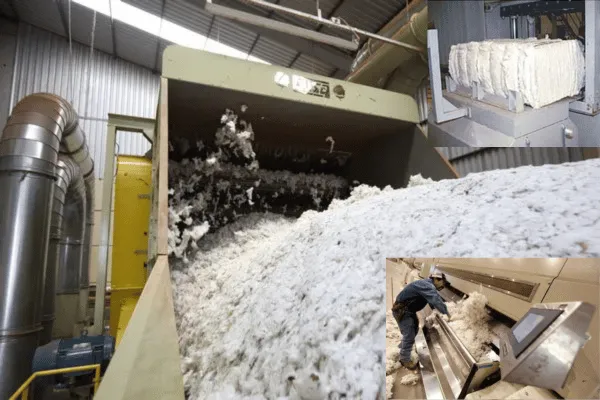Seed cotton is the freshly picked cotton that has seeds in it. The treading is done by following this condition also although normally the treading is done after separation of the fibres from their seed. So, the total processes that are involved in separating the cotton fibres from the seeds are termed ginning. Here I present the Cotton Ginning Process, its definition, various methods, and manufacturing technology.

What is Cotton Ginning?
The process of separating the seed from the cotton fibre is called ginning. The ideal ginning is the separation without any damage to the fibre. Ginning is the first mechanical process involved in processing cotton. A ginning mill separates cotton fibers from the seed bolls and dust particles. The main application of ginned cotton, referred to as lint, is for spinning operations, where lint is converted to yarn.
Objectives of Cotton Ginning:
- To make the fibre totally free from seed.
- To increase the quality of the fibre.
- To get a fair price for the product.
- To make the spinning process easy & effective.
- To collect the fibres & the seeds at a time in a separate passage.
Methods of Ginning
There are two methods of ginning:
- Manual method
- Mechanical method
- Manual Methods are Hand ginning, Foot roller ginning, and Charka ginning.
- Mechanical Methods are Saw ginning, Knife roller ginning, and Macarthy roller ginning.
Difference between Saw ginning & Roller ginning:
| Saw ginning | Roller ginning |
| 1. Used for the fibres which are not easily separated from the seeds. | 1. Used for the fibres which can easily be separated from the seeds. |
| 2. Used for short to medium staple fibre. | 2. Used for long staple fibre. |
| 3. Higher production rate up to 500 lbs/hour. | 3. Lower production rate up to 100-200 lbs/hour. |
| 4. It gives less clean lint. | 4. It gives more clean lint. |
| 5. Saw ginning tends to damage the fibre if precautions are not taken. | 5. Possibility of damaging the fibre is less. |
| 6. It contains more impurities. | 6. It contains less impurities. |
Cotton Ginning Manufacturing Process and Technology
The ginning process is shown in the flow chart given below. Seed cotton is fed grading system where grading is done, followed by pneumatic conveying. From here, it is fed to the preliminary cleaning process, followed by saw gin, lint cleaner,pre-bale press, and cotton bales. The Ginning Process involves two cleaning stages:
- Pre Cleaning
- Post Cleaning
The main operation of separating seed from cotton is done by a saw gin. In the ginhouse, after the ginning process is completed, the cotton lint and cotton seeds are separated, and the lint passes out through a pneumatic system to the Post-cleaner(Lint Cleaners), in which small impurities, dust particles, and small fibers are carried out, and the cotton becomes free from contamination.
Pressing:
Cleaned Lint is taken to the bale press, which compresses the ginned lint into bales that weigh around 170 kg. After pressing is completed, the bale is tightened and covered fully with cloth; after then, the bale is weighed and kept in the hall safely.
Packaging the Lint:
The bales are then wrapped with a protective cover, ready for delivery to the warehouse, where they are sold to various textile mills
Technology:
The technology required for the ginning & pressing operations is cotton ginning machinery, pre-cleaner, lint cleaner, Kappas conveyor system, lint conveyor system, Hydraulic cotton baling press, conveyor for seed, electrical infrastructure, Humidifier, and weighbridge etc. The other optional spinning machinery required is the foreign fibre detectors/removers.
Minimum economic size of the plant:
The minimum economic capacity of the ginning mill is about 24 Gins.
Yield and Production:
The yield of lint cotton is assumed at 32%, seed is assumed at 65%, and waste is assumed at 3%, which are based on the industrial norms and manufacturers’ specifications.
Investment:
The investment cost for setting up a ginning mill of 24 gins will be around Rs 9.64 Crores or BDT. 14.07 Crores Cand the breakup of the cost is tabulated below. The land requirement will be around 7 acres. The pre-operative expense includes interest during construction of Rs 0.24 crores. Plant & Machinery, including installation, erecting & commissioning charges, is of 2.63 crore. Buildings and civil works are estimated to be 2.73 crore. Contingencies, electricity deposits, are also considered in the project cost. Margin money for working capital is estimated to be 3.54 crore.
Estimated Project Cost
- Land & Site Development 0.17
- Buildings & Civil works 2.73
- Plant & Machinery including erc., ins.,& freight 2.63
- Electricity Deposits 0.12
- Preliminary Expenses 0.07
- Pre-operative Expenses 0.24
- Contingency @5% 0.14
- Margin Money for Working Capital 3.54
Total Project Cost Rs. 9.64or BDT 14.07 Crores.
- Reference: https://cottonaustralia.com.au
